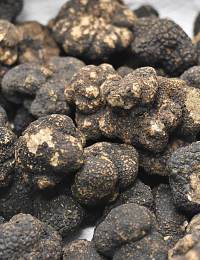
Did someone say “It’s black truffle season?” This past week, I had the pleasure of touring Sabatino’s factory with a group of my fellow students from The Culinary Institute of America! Sabatino has been donating truffles to the school for many years, making it possible for students just like me to work with this wonderful product on a daily basis. Walking through the doors of the factory, I instantly felt like I was in the heart of Umbria, Italy. The original factory was first opened in Umbria by Balestra and his wife, Giuseppina.

I have some answers to the questions we students asked while we were there, and I’d love to share them with you!
How are Truffles harvested?
They are harvested seasonally and with the help of a man’s best friend. Truffle hunters rely on highly trained dogs to find the roots of the trees where the truffles grow approximately 12 inches in the ground. Sabatino has five different varieties of truffles that they offer in any given year. When I visited, I was very lucky to actually enter the fresh lab of the factory. We, as students, had the opportunity to see the Black Winter, Tuber Melanosporum (November–March) truffles often described as having a dark, rough exterior with black flesh and white marbling. Below I have listed the other four truffles; this way you’ll know which season aligns with each truffle.
- Black Summer, Tuber Aestivum Vitt.: May–September
- Black Burgundy, Tuber Uncinatum: September–November
- White Truffle, Tuber Magnatum Pico: October–December
- Black Winter Australian, Tuber Melanosporum Vitt.: June–August

What’s the best way to store the truffles?
The answer is to make sure you keep them in a moisture-free area. All truffles release moisture over the course of a night. The greatest myth about storing truffles is to place them in the light. This will automatically draw all of the moisture out, thus decreasing their weight, which will then carry over into your product sales. To help ensure the best quality, you must individually wrap each truffle in a paper towel and store it in a tightly sealed container. Be sure to use a new paper towel for wrapping each night. Voila! You have the perfect method to store your truffles.

What’s the best way to serve truffles?
Until my visit, I had no idea the truffle industry was so huge! There are so many different ways Sabatino uses truffles in their products. One of the very useful things I learned was that grating the fresh truffle over a plate, will not only cover more surface area (because of the little pieces), it will also evenly distribute them on the dish. This ensures a truffle taste in every bite! As a chef, this is something that is very useful because you are saving on cost but still plating a very tasteful dish. There is also a large market for truffle oils, salts, seasonings, and even honey—for pastry chefs!

What does mass production mean?
Because the shelf life of a truffle is about three-four days, production has to happen very quickly. For example, Sabatino has machines that can produce 1,200 to 3,000 bottles of their new soy sauce per day. Talk about fast production!
I hope this answers at least some of your questions about the magnificent truffle. A special thanks to Sabatino for allowing CIA students to come and experience a day in the life of a truffle! It is an experience that will stick with us forever!

Baking & Pastry student, Angelica Martinez, in the Bocuse Restaurant playing around with Sabatino’s collaboration of Crown Maple Syrup and Truffles on the “Charlotte Dessert.”

A dish made with Sabatino’s truffle flour, zest, juice, oil, and purée called, “Truffle Cavatelli”, by our culinary students, in the Bocuse Restaurant.
By Olivia Weidner
[starbox id=30]
